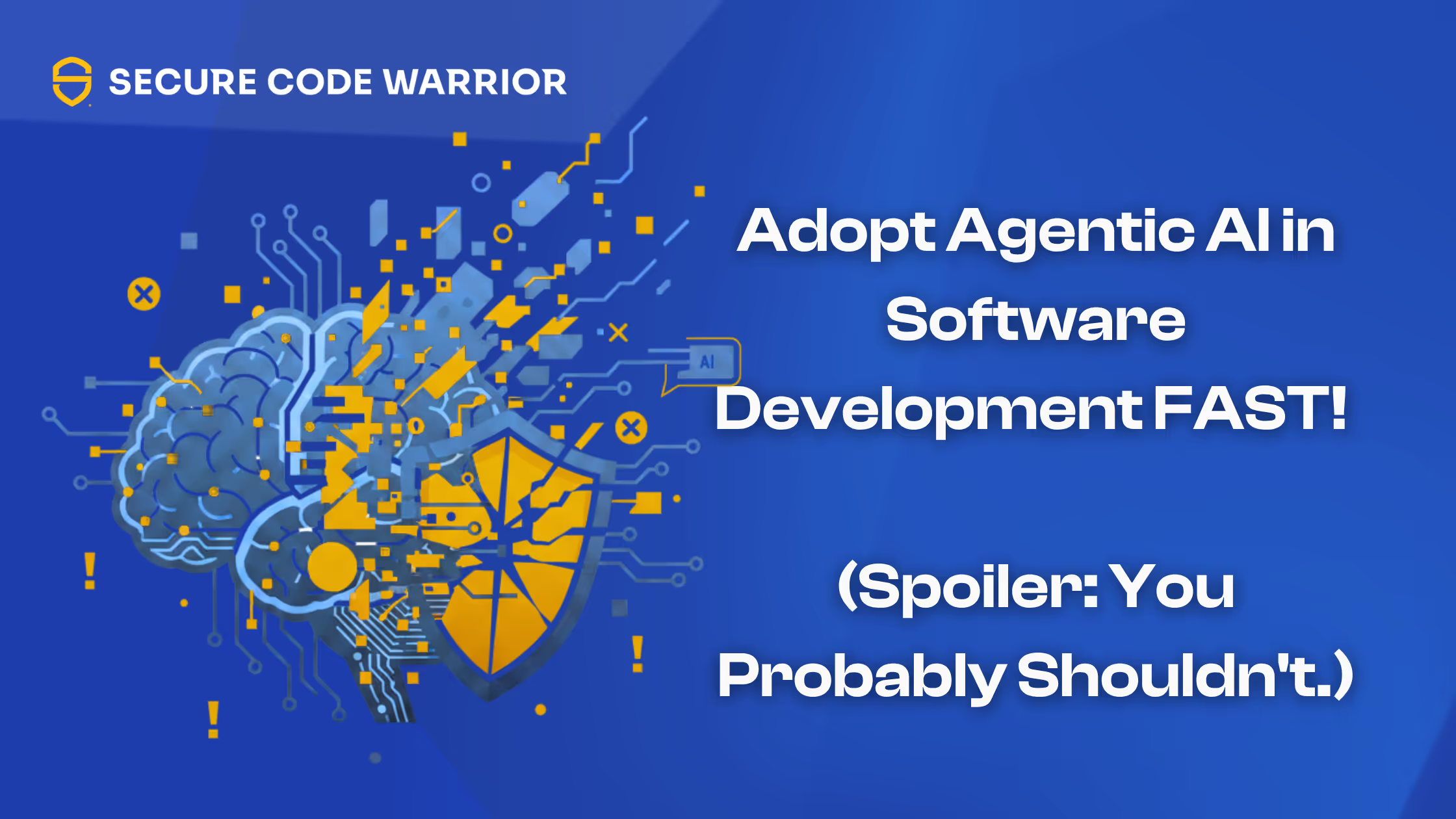
Shifting Left
If a developer writes a cross-site scripting error as they're coding in JavaScript, and they're able to detect that within minutes of creating that flaw, it will likely only require minutes or seconds to fix.
Whereas if that flaw is discovered two weeks later by a manual tester, that's going to be then entered into a defect tracking system. It's going to be triaged. It's going to be put into someone's bug queue.
With the delay in identification, it will have to be researched in its original context and will slow down development. Now, you're potentially talking hours of time to fix the same flaw. Maybe a scale of 10 or 100 times more time is taken
I couldn't agree with Chris Wysopal (CTO, Veracode) more in his recent podcast with O'Reilly Security Podcast where he explains why shifting security to the left (to developers at the start of the development life cycle) is key in an agile environment to keep up the pace and speed.
Security should be made easy for developers by using IDE plug-ins, scanners and educating them to have the basic security skills (hygiene). Organisations should not be solely relying on security experts or a centralised security team who validates all changes.
Our typical security modus operandi is broken (call in the expert!) and we need to integrate security into development teams to ensure quality is maintained whilst staying agile.


If a developer writes a cross-site scripting error as they're coding in JavaScript, and they're able to detect that within minutes of creating that flaw
Chief Executive Officer, Chairman, and Co-Founder

Secure Code Warrior is here for your organization to help you secure code across the entire software development lifecycle and create a culture in which cybersecurity is top of mind. Whether you’re an AppSec Manager, Developer, CISO, or anyone involved in security, we can help your organization reduce risks associated with insecure code.
Book a demoChief Executive Officer, Chairman, and Co-Founder
Pieter Danhieux is a globally recognized security expert, with over 12 years experience as a security consultant and 8 years as a Principal Instructor for SANS teaching offensive techniques on how to target and assess organizations, systems and individuals for security weaknesses. In 2016, he was recognized as one of the Coolest Tech people in Australia (Business Insider), awarded Cyber Security Professional of the Year (AISA - Australian Information Security Association) and holds GSE, CISSP, GCIH, GCFA, GSEC, GPEN, GWAPT, GCIA certifications.


If a developer writes a cross-site scripting error as they're coding in JavaScript, and they're able to detect that within minutes of creating that flaw, it will likely only require minutes or seconds to fix.
Whereas if that flaw is discovered two weeks later by a manual tester, that's going to be then entered into a defect tracking system. It's going to be triaged. It's going to be put into someone's bug queue.
With the delay in identification, it will have to be researched in its original context and will slow down development. Now, you're potentially talking hours of time to fix the same flaw. Maybe a scale of 10 or 100 times more time is taken
I couldn't agree with Chris Wysopal (CTO, Veracode) more in his recent podcast with O'Reilly Security Podcast where he explains why shifting security to the left (to developers at the start of the development life cycle) is key in an agile environment to keep up the pace and speed.
Security should be made easy for developers by using IDE plug-ins, scanners and educating them to have the basic security skills (hygiene). Organisations should not be solely relying on security experts or a centralised security team who validates all changes.
Our typical security modus operandi is broken (call in the expert!) and we need to integrate security into development teams to ensure quality is maintained whilst staying agile.

If a developer writes a cross-site scripting error as they're coding in JavaScript, and they're able to detect that within minutes of creating that flaw, it will likely only require minutes or seconds to fix.
Whereas if that flaw is discovered two weeks later by a manual tester, that's going to be then entered into a defect tracking system. It's going to be triaged. It's going to be put into someone's bug queue.
With the delay in identification, it will have to be researched in its original context and will slow down development. Now, you're potentially talking hours of time to fix the same flaw. Maybe a scale of 10 or 100 times more time is taken
I couldn't agree with Chris Wysopal (CTO, Veracode) more in his recent podcast with O'Reilly Security Podcast where he explains why shifting security to the left (to developers at the start of the development life cycle) is key in an agile environment to keep up the pace and speed.
Security should be made easy for developers by using IDE plug-ins, scanners and educating them to have the basic security skills (hygiene). Organisations should not be solely relying on security experts or a centralised security team who validates all changes.
Our typical security modus operandi is broken (call in the expert!) and we need to integrate security into development teams to ensure quality is maintained whilst staying agile.

Click on the link below and download the PDF of this resource.
Secure Code Warrior is here for your organization to help you secure code across the entire software development lifecycle and create a culture in which cybersecurity is top of mind. Whether you’re an AppSec Manager, Developer, CISO, or anyone involved in security, we can help your organization reduce risks associated with insecure code.
View reportBook a demoChief Executive Officer, Chairman, and Co-Founder
Pieter Danhieux is a globally recognized security expert, with over 12 years experience as a security consultant and 8 years as a Principal Instructor for SANS teaching offensive techniques on how to target and assess organizations, systems and individuals for security weaknesses. In 2016, he was recognized as one of the Coolest Tech people in Australia (Business Insider), awarded Cyber Security Professional of the Year (AISA - Australian Information Security Association) and holds GSE, CISSP, GCIH, GCFA, GSEC, GPEN, GWAPT, GCIA certifications.
If a developer writes a cross-site scripting error as they're coding in JavaScript, and they're able to detect that within minutes of creating that flaw, it will likely only require minutes or seconds to fix.
Whereas if that flaw is discovered two weeks later by a manual tester, that's going to be then entered into a defect tracking system. It's going to be triaged. It's going to be put into someone's bug queue.
With the delay in identification, it will have to be researched in its original context and will slow down development. Now, you're potentially talking hours of time to fix the same flaw. Maybe a scale of 10 or 100 times more time is taken
I couldn't agree with Chris Wysopal (CTO, Veracode) more in his recent podcast with O'Reilly Security Podcast where he explains why shifting security to the left (to developers at the start of the development life cycle) is key in an agile environment to keep up the pace and speed.
Security should be made easy for developers by using IDE plug-ins, scanners and educating them to have the basic security skills (hygiene). Organisations should not be solely relying on security experts or a centralised security team who validates all changes.
Our typical security modus operandi is broken (call in the expert!) and we need to integrate security into development teams to ensure quality is maintained whilst staying agile.
Table of contents
Chief Executive Officer, Chairman, and Co-Founder

Secure Code Warrior is here for your organization to help you secure code across the entire software development lifecycle and create a culture in which cybersecurity is top of mind. Whether you’re an AppSec Manager, Developer, CISO, or anyone involved in security, we can help your organization reduce risks associated with insecure code.
Book a demoDownloadResources to get you started
Kamer van Koophandel Sets the Standard for Developer-Driven Security at Scale
Kamer van Koophandel shares how it embedded secure coding into everyday development through role-based certifications, Trust Score benchmarking, and a culture of shared security ownership.
Threat Modeling with AI: Turning Every Developer into a Threat Modeler
Walk away better equipped to help developers combine threat modeling ideas and techniques with the AI tools they're already using to strengthen security, improve collaboration, and build more resilient software from the start.











%20(1).avif)
.avif)

.avif)



